
Reviews Review of Mahler’s 8th Symphony Virginia Symphony’s incredible performance of Mahler’s Eighth Symphony was a once-in-a-lifetime event. Now the problem with once-in-a-lifetime experiences is that one tends to burble! “You should have been there; it was fantastic!” and so on. But you should have — and it was.
In her 20-year tenure as conductor, Falletta has led the symphony in all of Mahler’s other symphonies, an exceptional accomplishment for any orchestra. This was the crowning piece, the pièce de résistance. Composed in eight weeks during the summer of 1906, it combines two transcendent statements of faith — the medieval Latin hymn to the Holy Spirit, Veni Creator Spiritus, in the first movement and in the second, the final scene of Goethe’s Faust, in which Faust’s soul is brought into heaven and welcomed by the heavenly host. The first movement began with an organ blast; then came the massed choirs — the Virginia Symphony Orchestra Chorus, and the Richmond Symphony Chorus (the first time those two groups have performed together); the Old Dominion University Concert Choir and the Christopher Newport University Chamber Choir — and not least, the Virginia Children’s Chorus, notable for its clarity of diction and purity of tone. Falletta’s crisp baton held it all together: fast and slow sections, marches and fanfares, a delicate violin passage beautifully played by Vahn Armstrong, subtle basses and cellos, silvery woodwinds, warm French horns, vigorous trumpets, evocative harps (yes, two of them) — combined with soloists who could both project and blend with one another.
At the finale, Falletta brought out the full power of chorus, orchestra, organ and soloists; then, in the very last measures, she turned around to face the audience, arms outstretched, eyes closed, completely transported by the music, before giving the final cutoff. I would not have been surprised to see her levitate — lift right off the podium and rise into heaven with Faust. 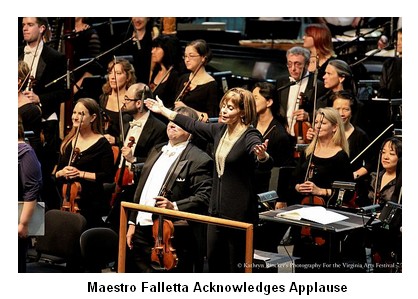 The audience erupted — and rightly so. The performance was recorded for later release — but no recording could reproduce the physical effect of the music on those who were lucky enough to be there. This is what live music is all about, at its very best. This review was originally broadcast on WHRO 90.3 FM’s “From the other side of the Footlights.” Personal Notes on Mahler’s 8th Symphony During the Virginia Arts Festival each spring there is one blockbuster production and Gustav Mahler (1860-1911) Symphony No. 8 was this year’s choice. Over the past few years conductor JoAnn Falletta has programmed all of Mahler’s symphonies except this one. It is a major undertaking and rarely performed because of the musical forces required. Most of the audience knew the piece only from recordings, if at all. Even JoAnn Falletta had not heard a live performance before. This production had 120 instrumentalists, including organ and extra brass players in the dress circle for key musical climaxes. There were eight vocal soloists and 375 chorus members: Christopher Newport University (22 singers led by Lauren Fowler-Calisto, director of choral studies), Old Dominion University (53 singers led by Nancy Klein, director of choirs), Richmond Symphony Chorus (173 singers led by Erin R. Freeman, associate conductor), Virginia Childrens Chorus (85 singers led by Carol Thomas Downing, artistic director), and Virginia Symphony Chorus (92 singers led by Robert Shoup, chorusmaster and staff conductor). 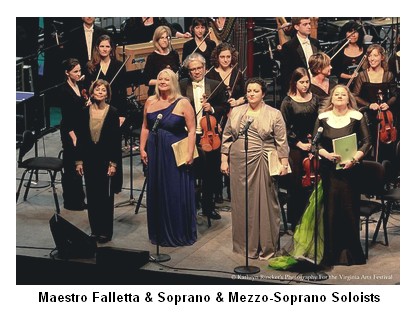 The lineup of soloists was impressive. The seven singers on stage were sopranos Jennifer Check and Rebecca Nash, mezzo-sopranos Ann McMahon Quintero and Robynne Redmon, tenor Gregory Carroll, baritone Lester Lynch and bass Jason Grant. The third soprano, Jennifer Welch-Babidge, was heard only from the dress circle. 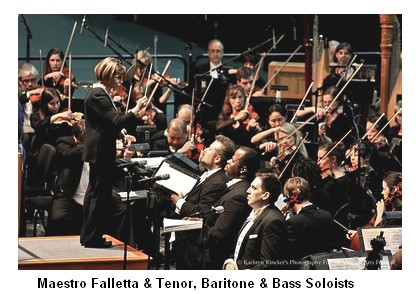 “Mahler greatly expanded the length of the symphonic form, its emotional range and the role and color of voice and instruments. His music is the profound personal expression of his intense spiritual experiences.” (Atlantic Brief Lives, pg. 480. Editor Louis Kronenberger. Beginning in the 1960’s Mahler's music finally became popular and available on recordings. Lucky for me I was a teenager when Columbia Records was promoting Leonard Bernstein’s recordings of the Mahler Symphonies, bringing them into the standard repertory. Mahler’s life and music speak to the meaning and personal anxieties of our age. Mahler’s struggle to make sense out of life passes through his music to the listener. The open, emotional approachability in his music is what attracted me. Norman Lebrecht in his book, Why Mahler, says Mahler’s music describes the world in its untidiness in a language that is not astringent, novel nor surreal. But rather an everyday vernacular made up of flashbacks, and fast-forwards, stray colloquialisms, misplaced consonants and forbidden thoughts. The performance began at 3:13 and the glorious choral and orchestral opening of Veni Creator Spiritus (Come creative spirit and fill our hearts with grace and love) was an immediate and overwhelming experience as if the universe were shouting in celebration of its existence. The seven soloists stood and sang verse after verse of this ancient hymn. The intensity built up to the Gloria which has all the passion, strength and beauty that we long for in music but have seldom heard before. Trumpets and trombones sound from the dress circle and we were totally surrounded and overwhelmed by the voices of the huge choir. After this climax I wondered how I could stand that much intensity for another hour but then the second movement began with the delicate, sensual, instrumental Poco adagio which soothed us and carried us forward into music that created a feeling of yearning and sadness. The soloists were now seated with eyes downcast, listening intently. My mental images were of a delicate sunrise furtively stealing onto the horizon (it called to mind the Act III dawn in Puccini’s Tosca. The delicate chamber music following the monumentalism of the opening movement was stunning. Special thanks to Kathryn Rincker for permission to use her photographs of the William and Mary Hall and Chrysler Hall performances. www.kathrynrinckersphotography.com Printable Version Back to Top
|
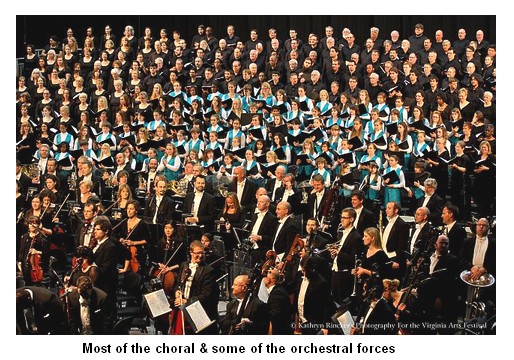 Mahler’s Eighth is called “the symphony of a thousand,” and if there weren’t quite a thousand singers and musicians jammed onto the Chrysler Hall stage, the numbers were pretty awesome: There were half again as many musicians than usual. There were hundreds of singers, rank on disciplined rank of them, from five different choruses; I’ve never seen the Chrysler Hall stage open to the back wall before. There were eight soloists — three sopranos, two mezzos, a tenor, a baritone and a bass-baritone — and leading them all was our extraordinary conductor JoAnn Falletta.
Mahler’s Eighth is called “the symphony of a thousand,” and if there weren’t quite a thousand singers and musicians jammed onto the Chrysler Hall stage, the numbers were pretty awesome: There were half again as many musicians than usual. There were hundreds of singers, rank on disciplined rank of them, from five different choruses; I’ve never seen the Chrysler Hall stage open to the back wall before. There were eight soloists — three sopranos, two mezzos, a tenor, a baritone and a bass-baritone — and leading them all was our extraordinary conductor JoAnn Falletta.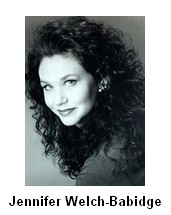 Sopranos Jennifer Check and Rebecca Nash and mezzos Ana McMahon Quintero and Robynne Redmon were stunning, singly and in duos and trios. High in the balcony, soprano Jennifer Welch-Babidge sang like an angel. Baritone Lester Lynch was impassioned and commanding; bass-baritone Jason Grant sang with dramatic physical as well as vocal expression. Tenor Gregory Carroll cracked on a top note, but it was a very brief error, and overall, his performance was excellent.
Sopranos Jennifer Check and Rebecca Nash and mezzos Ana McMahon Quintero and Robynne Redmon were stunning, singly and in duos and trios. High in the balcony, soprano Jennifer Welch-Babidge sang like an angel. Baritone Lester Lynch was impassioned and commanding; bass-baritone Jason Grant sang with dramatic physical as well as vocal expression. Tenor Gregory Carroll cracked on a top note, but it was a very brief error, and overall, his performance was excellent.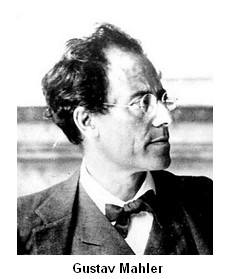 Of the 8th Symphony Mahler said “Imagine the universe beginning to sing and resound. It is no longer human voices; it is planets and suns revolving.”
Of the 8th Symphony Mahler said “Imagine the universe beginning to sing and resound. It is no longer human voices; it is planets and suns revolving.”